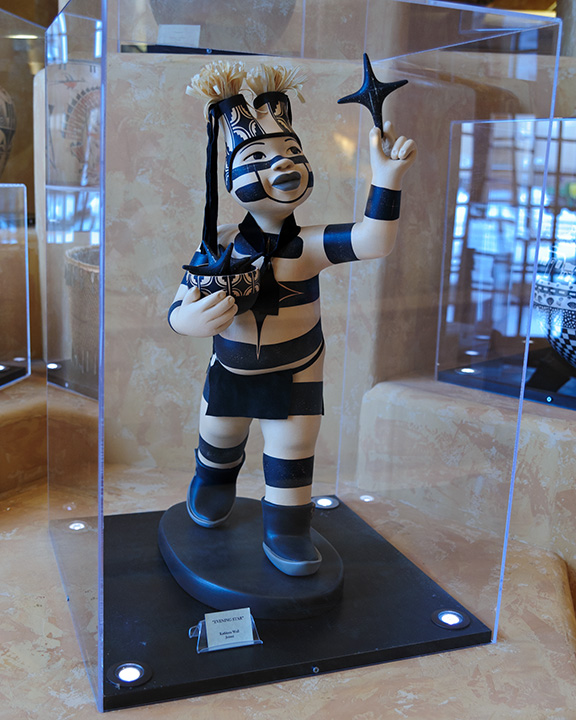Koshare Indian Museum on:
[Wikipedia]
[Google]
[Amazon]
 The Pueblo clowns (sometimes called sacred clowns) are
The Pueblo clowns (sometimes called sacred clowns) are
Gutenberg etext of Adolf Bandelier ''The Delight Makers''
*P. Farb, ''Man's Rise to Civilisation'', 1971. * M. Conrad Hyers
The Spirituality of Comedy: comic heroism in a tragic world
' 1996 Transaction Publishers *Elsie Clews Parsons ''Pueblo Indian Religion'', University of Chicago Press, 1939. *Elsie Clews Parsons and Ralph L. Beals,
The Sacred Clowns of the Pueblo and Mayo-Yaqui Indians
'
Rainmakers from the Gods: Hopi Katsinam, Peabody Museum online exhibition
{{Clowns Hopi mythology Ritual clowns
 The Pueblo clowns (sometimes called sacred clowns) are
The Pueblo clowns (sometimes called sacred clowns) are jester
A jester, court jester, fool or joker was a member of the household of a nobleman or a monarch employed to entertain guests during the medieval and Renaissance eras. Jesters were also itinerant performers who entertained common folk at fairs ...
s or trickster
In mythology and the study of folklore and religion, a trickster is a character in a story ( god, goddess, spirit, human or anthropomorphisation) who exhibits a great degree of intellect or secret knowledge and uses it to play tricks or otherwi ...
s in the Kachina religion (practiced by the Pueblo natives of the southwestern United States). It is a generic term, as there are a number of these figures in the ritual practice of the Pueblo people. Each has a unique role; belonging to separate Kivas
A kiva is a space used by Puebloans for rites and political meetings, many of them associated with the kachina belief system. Among the modern Hopi and most other Pueblo peoples, "kiva" means a large room that is circular and underground, ...
(secret societies or confraternities) and each has a name that differs from one mesa or pueblo to another.
Roles
The clowns perform monthly rituals, summer (for rain), November - for the gods, for curing society, black magic. Among the Hopi/Tewa there are four distinct clowns. The Koyi'msĭ (also called Ho'tomeli'pung Tewa. Ta'chûktĭ); Chüʳkü'wĭmkya; Pai'yakyamü or Koyala; Koyi'msĭ (also called Ta'chûktĭ) and Pi'ptuyakyamü (or "arrivals"). In order for a clown to perform meaningful social commentary via humor, the clown's identity must usually be concealed. The sacred clowns of the Pueblo people, however, do not employ masks but rely on body paint and head dresses. Among the best known orders of the sacred Pueblo clown is the ''Chiffoneti'' (called ''Payakyamu'' inHopi
The Hopi are a Native American ethnic group who primarily live on the Hopi Reservation in northeastern Arizona, United States. As of the 2010 census, there are 19,338 Hopi in the country. The Hopi Tribe is a sovereign nation within the United ...
, ''Kossa'' in the Tewa language, ''Koshare'' among the Keres people, ''Tabösh'' at Jemez, New Mexico, and ''Newekwe'' by the Zuñi). These individuals present themselves with black and white horizontal stripes painted on their bodies and faces, paint black circles around the mouth and eyes, and part their hair in the center and bind it in two bunches which stand upright on each side of the head and are trimmed with corn husks.
The mudheads (called ''Koyemshi'' in Zuni, and ''Tatsuki'' in Hopi) are usually portrayed by pinkish clay coated bodies and matching cotton bag worn over the head.
Anthropologists, most notably Adolf Bandelier in his 1890 book, ''The Delight Makers'', and Elsie Clews Parsons
Elsie Worthington Clews Parsons (November 27, 1875 – December 19, 1941) was an American anthropologist, sociologist, folklorist, and feminist who studied Native American tribes—such as the Tewa and Hopi—in Arizona, New Mexico, and M ...
in her ''Pueblo Indian Religion'', have extensively studied the meaning of the Pueblo clowns and clown society in general. Bandelier notes that the Tsuku were somewhat feared by the Hopi as the source of public criticism and censure of non-Hopi like behavior. Their function can help defuse community tensions by providing their own humorous interpretation of the tribe's popular culture, by reinforcing taboos, and by communicating traditions. A 1656 case of a young Hopi man impersonating the resident Franciscan priest at Awat'ovi is thought to be a historic instance of Pueblo clowning.Daughters, Anton. "A Seventeenth-Century Instance of Hopi Clowning? The Trial of Juan Suni, 1659. ''Kiva'' Vol. 74, No. 4, Summer 2009
See also
* HeyokaNotes
References
Gutenberg etext of Adolf Bandelier ''The Delight Makers''
*P. Farb, ''Man's Rise to Civilisation'', 1971. * M. Conrad Hyers
The Spirituality of Comedy: comic heroism in a tragic world
' 1996 Transaction Publishers *Elsie Clews Parsons ''Pueblo Indian Religion'', University of Chicago Press, 1939. *Elsie Clews Parsons and Ralph L. Beals,
The Sacred Clowns of the Pueblo and Mayo-Yaqui Indians
'
American Anthropologist
''American Anthropologist'' is the flagship journal of the American Anthropological Association (AAA), published quarterly by Wiley. The "New Series" began in 1899 under an editorial board that included Franz Boas, Daniel G. Brinton, and John ...
, New Series, Vol. 36, No. 4 (October–December, 1934), pp. 491–514
*Pecina, Ron and Pecina, Bob. ''Hopi Kachinas: History, Legends, and Art''. Schiffer Publishing Ltd. 2013; . Pages 124-138.
*J. H. Steward, ''The Ceremonial Buffoons of the American Indians'', Michigan Academy of Sciences, pp 187–207, 1930.
* Alison Freese, `Send in the Clowns: An Ethnohistorical Analysis of the Sacred Clowns' Role in Cultural Boundary Maintenance Among the Pueblo Indians' (doctoral thesis, University of New Mexico, 1991)
External links
Rainmakers from the Gods: Hopi Katsinam, Peabody Museum online exhibition
{{Clowns Hopi mythology Ritual clowns